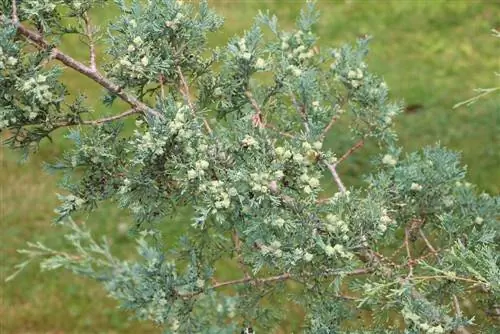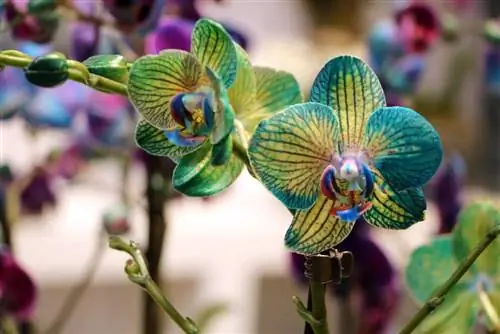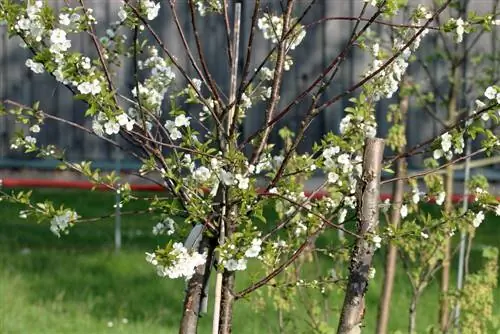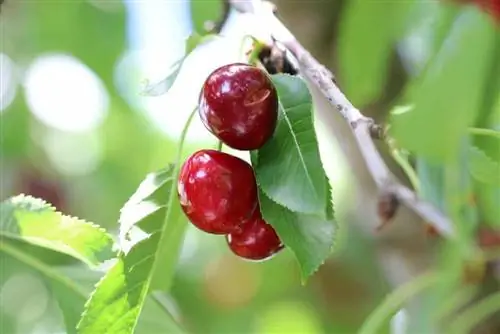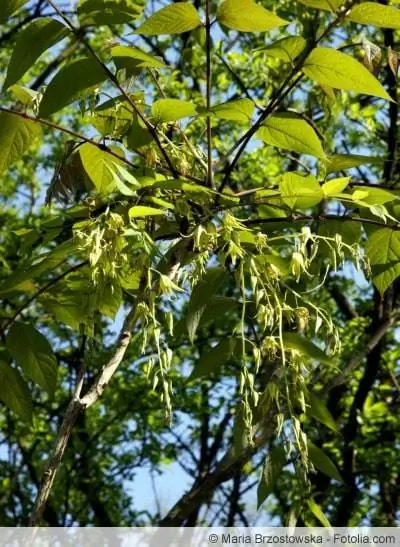- Author admin [email protected].
- Public 2023-12-17 03:39.
- Last modified 2025-06-01 06:48.
Scale-like leaves and small cones are the hallmarks of false cypresses. A special beauty from this group of ornamental trees is Chamaecyparis lawsoniana Columnaris. With its striking foliage, which shimmers from blue to blue-green depending on the viewing angle and light, the plant is by no means inconspicuous. The tree is considered robust, easy to care for and tolerates cutting. At times, the blue cypress can also be cultivated in pots. There are a few special features you should take into account when caring for perennial plants.
Location
Chamaecyparis lawsoniana, the blue false cypress, is one of the most beautiful representatives of its kind with its striking leaf coloring. The evergreen tree can reach a maximum height of up to 6 m. Characteristic of the cypress family is its columnar, upright and compact growth. Its shape and slow growth make the Columnaris columnar cypress interesting as a hedge plant. When planted correctly, the plant's evergreen foliage provides year-round protection from wind and the prying eyes of neighbors. The conifer species also comes into its own as a solitary plant. The shrub with the scale-like leaves is robust, you should consider a few factors when choosing the location:
- Planted individually, Columnaris can grow up to 175 cm wide
- When creating hedges, the legal minimum distance to neighboring properties must be taken into account
- Mock cypresses have shallow roots
- Not suitable for underplanting coniferous and deciduous trees
The plant copes well with light partial shade. The dark green splendor of the leaves comes into its own here. Full sun locations are tolerated, but the substrate can dry out more quickly. For this reason, you should water young and newly planted plants more often. Shady places in the garden are only partially suitable for the blue cypress. A lack of light is visually noticeable in growth and the plant becomes susceptible to diseases and pests. The columnar cypress should have a few hours of sunshine a day.
Tip:
In the first 3 to 4 years of life, the shallow-rooted plants can be cultivated in large containers without much effort.
Substrate
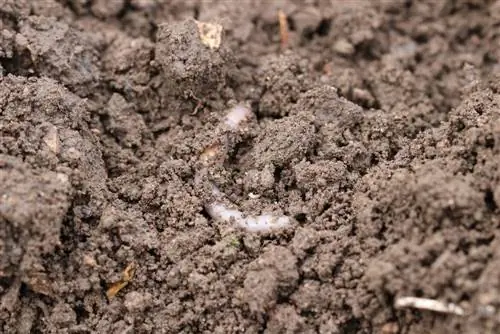
The consistency of the soil plays an important role and contributes significantly to the development of the plants. A large number of passionate hobby gardeners leave nothing to chance and use analyzes to determine the overall condition of the soil. The blue cypress is usually undemanding. Preparation of the substrate is still recommended for perennial plants. The following conditions have proven successful:
- Nutrient Rich
- Permeable
- Profound
- Wet
- ph value can be acidic to alkaline
Heavy soils, for example with a high clay content, make it difficult to keep and care for many plants. The water seeps away slowly and the roots cannot exchange oxygen. It is not strenuous work to prepare this soil for the Columnaris columnar cypress. Mix the soil around the planting site with large amounts of sand. When mulching the soil, you should also occasionally incorporate this material. However, do this carefully so as not to create a substrate that is too dry. Because Chamaecyparis lawsoniana likes a moist environment. A balanced mixture of clay and sand is necessary so that the irrigation and rain water does not evaporate too quickly. If you have false cypresses in a pot, you can use conventional potting soil.
Pouring
Evergreen plants have a decisive advantage over deciduous plants: Even in the cold season, they lose none of their dark green leaves. However, this advantage comes at a price that becomes noticeable in care. The root ball of these plants must not dry out even in winter. Chamaecyparis lawsoniana is no exception. The majority of evergreen plants die in the cold season not from cold, but from drought.
- The blue cypress needs basic moisture in the soil
- In winter, watering is done on frost-free days
- A high lime content in the water does not harm the plants
- Avoid waterlogging
Drainage has proven useful for potted plants and in the ground. With this tool you can ensure that the roots of the plants are not in water. The Columnaris columnar cypress likes it moist, waterlogging can cause considerable damage to the underground parts of the plant and make them susceptible to root rot.
- Work small pebbles or expanded clay balls into the garden soil
- A layer of porous material is created at the bottom of the planter
- Bas alt, lava grit and fine clay shards have proven effective for this task
For solitary plants in the bed, you should work with a watering edge. This consists of soil arranged in a cone around the trunk and slightly flattened. Keep this area weed-free. Watering takes place in the morning and afternoon. This will prevent the water from evaporating too quickly during lunchtime. Apply a thick layer of bark mulch around the columnar cypress. This will prevent the soil from drying out too quickly. The pieces of bark slowly rot and enrich the soil with important nutrients during this time.
Propagate
Chamaecyparis lawsoniana 'Columnaris' and many other conifer species are available all year round in nurseries and well-stocked garden centers. You can also propagate existing plants using cuttings. The ideal time for this measure is between July and September. To increase the chances of success, you should take several cuttings.
- Select slightly woody, strong shoots
- These are cut to a length between 8 - 12 cm
- Bevel the interface with a knife
- The branches and foliage are removed from the lower end of the shoot
- Place the cutting 2/3 deep in lean potting soil
- Keep the substrate evenly moist
Rooting can be done in a prepared bed in the garden. However, it is recommended to grow the cuttings on the warm windowsill. Avoid locations in full sun. Even in winter sunlight, the soil can dry out quickly, which can lead to the death of young plants. Increase the humidity with an improvised greenhouse made from shish kebab skewers and perforated foil. Temperatures between 18° - 22° C are ideal for the development of roots.
After around 8 to 10 weeks, under optimal conditions, a fine network of roots should have formed in the container. Prick out the young Columnaris columnar cypresses in good time, before the underground parts of the plant grow together and have difficulty separating from each other. If you want strong, he althy plants, you can use a trick. Cultivate the evergreen Columnaris exclusively in a container for the first two years of life. Here you can have a direct influence on the shape and growth. With the first warm rays of sunshine in spring, the false cypress should move into the garden. In the first few days, protection from direct sunlight is advisable. The young plants are not used to UV radiation and the foliage reacts by discoloring and burning.
Fertilize
The growth of conifers from North America and Asia is moderate to moderate. The plants are not heavy-feeding plants, but they do depend on a balanced supply of nutrients. In the garden, it is sufficient if you work compost into the soil in spring and late summer. Horn shavings and brushwood have also proven useful. Alternatively, you can use a long-term or liquid fertilizer from specialist retailers.
- Use a special conifer fertilizer for hedges
- Fertilization takes place between March and the end of August
- Do not exceed the dosage stated on the package insert
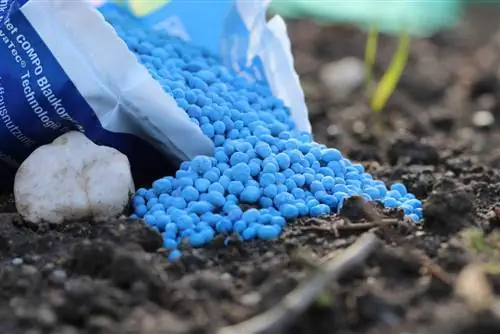
The color of the false cypress is strikingly beautiful, but it also has a disadvantage: the bluish-green foliage of the plant makes it difficult to detect an overdose or underdose of nutrients in time. Observe the plant closely and react as soon as the shoots hang limply or quickly growing “water shoots”, branches that grow crosswise, form. If over-fertilization occurs, the supply of minerals should be stopped immediately. It takes a few months for the conifer to recover. If a nutrient deficiency is detected, fertilization is carried out immediately. Do not exceed this dose to avoid further damaging the plant.
You should not apply compost or liquid fertilizer between September and February. The evergreen plant is in the vegetation break. Too high a level of nutrients at this time can “burn” the roots and affect the frost resistance of the false cypress.
Planting solitary plants
Chamaecyparis lawsoniana is a shallow-rooted plant. With increasing age, the network of roots that runs close to the ground can reach an immense length. Only a few strands of skin penetrate deeper layers of the earth. Take this into account when choosing the location. Power cables that are specifically laid underground can be damaged by plants. The evergreen ornamental plant can cope with root pressure from plant neighbors. With a width of up to 175 cm, the blue cypress is suitable for cultivation as a solitary plant. The plant picturesquely frames entrance areas in the garden and separates individual areas from view.
Purchased plants in pots should be given a sufficient bath in lukewarm water before being moved outdoors. Submerge the roots until no more air bubbles form. In this way you create optimal starting conditions for the cypresses. You can plant evergreen plants in the garden all year round. However, late summer or early autumn has proven to be the best time. There is enough time for the exotic beauties to acclimatise to their new location and survive the winter unscathed. Proceed as follows when planting:
- Dig a hole that is twice the size of the cypress root ball
- The substrate is enriched with humus
- If necessary, add expanded clay, sand and/or clay in small amounts
- Generously loosen the surrounding soil
- Insert the plant up to the upper root collar
- Fill back prepared soil and press firmly
- Smear properly
Creating hedges
Blue cypresses are impressive plants that offer adequate privacy thanks to their dense, evergreen foliage. When planting hedges you should pay attention to a few special features. It is helpful to first get a rough overview of the process. Sticks or wooden slats and barrier tape will help you mark out the planned area. In this preparation phase, a change is made quickly. Moving the planted conifers requires enormous effort.
Dig the garden area generously to a depth of 35 cm. Enrich the excavated soil with compost and fine pebbles. Regular mulching is difficult in the lower area of the hedge; the stones permanently loosen the soil. The minimum distance between the individual false cypresses depends on their size. Between 2 to 4 copies per square meter have proven successful. For small plants you can plant several plants next to each other.
Cutting
Mock cypresses tolerate pruning and can be “trained” into unusual shapes with patience and effort. If you want to take such a measure, you should start with young plants. The perennials cannot tolerate radical cutting back into old wood. As soon as you remove the green area of the woody shoots, they can no longer sprout. Young side shoots cover the bare spots over time.
- Pruning and shaping is done in the spring before budding
- Hedge trees are also cut in late summer
- You can remove annoying and dead plant parts all year round
- Use gloves when working, the plant sap is poisonous
The Columnaris columnar cypress has one crucial disadvantage: as the plant ages, it becomes bald from the inside out. Even regular pruning and proper care can only delay this decline, not stop it. It is not uncommon for many gardeners to completely remove hedges after 10 to 12 years due to the visual defect.
Wintering
The extraordinary ornamental tree is hardy; even double-digit temperatures below zero and a thick blanket of snow cannot harm the plants in the bed. Plants in pots are an exception. With these, there is a risk that frost will freeze the substrate in the container and the roots will suffer irreparable damage. In the fall, wrap the pot with burlap and keep the false cypresses close to house walls. During the cold season you should occasionally check the substrate and water it if necessary.
Conclusion
Chamaecyparis lawsoniana Columnaris is an interesting plant that stands out due to its unusual leaf coloring. With its evergreen foliage, the tree also brings color to the winter garden. Cultivating false cypresses requires little effort and time. The idea of creating a hedge with the distinctive conifers should be carefully considered. Over the years the plants become bare. In addition, the blue-greenish color of the leaves takes some getting used to and can quickly become annoying on a larger area.

